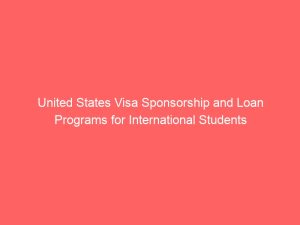Studying in the United States is a dream for millions of students across the world. However, one of the biggest challenges international students face is the cost of tuition, living expenses, and other financial requirements. For many students, getting a visa sponsorship along with a loan can make this dream possible. The good news is that there are structured programs, universities, and private organizations in the U.S. that offer both visa sponsorship and loan assistance to qualified students. This article explores in detail how international students can access visa sponsorship, secure funding, and make their way to study in the United States successfully.
Understanding Visa Sponsorship for International Students
Visa sponsorship means that an individual, company, or educational institution takes responsibility for supporting a foreign national’s visa application to live and study in the United States. For international students, the most common type of visa is the F-1 student visa, but there are other visa categories such as the J-1 (exchange visitor) visa or M-1 (vocational training) visa.
When a U.S. university admits an international student, they often provide the required documents, such as the I-20 form for F-1 visas, which acts as proof of sponsorship for the visa application. This sponsorship covers legal permission to study in the country but does not necessarily cover financial costs—this is where loans and scholarships come in.
Why Loans Are Important for International Students
The average cost of attending a university in the United States can range between $25,000 to $60,000 per year, depending on the institution. This amount includes tuition fees, accommodation, food, transportation, health insurance, and personal expenses. Without financial assistance, many international students cannot afford such costs.
Student loans designed for international students help bridge this gap. These loans can come from U.S.-based lenders, banks in the student’s home country, or specialized educational funding organizations. Some of these programs are tied to visa sponsorship arrangements or offered to students studying under specific visa categories.
Combining Visa Sponsorship and Loan Assistance
For international students, securing both visa sponsorship and a loan is the ultimate combination for funding their education in the United States. Here’s how it works:
- University Admission and Visa Sponsorship – The first step is gaining admission to a U.S. institution that accepts international students and can issue the I-20 form for F-1 visas.
- Loan Application – Once admitted, students can apply for educational loans, either from U.S. lenders that support international students or from financial institutions in their home country that provide overseas study loans.
- Financial Proof for Visa Approval – U.S. embassies require students to show proof of funds before granting a visa. A loan approval letter, combined with any scholarships or personal savings, can serve as this proof.
U.S. Loan Options for International Students
While many U.S. federal student loans are restricted to U.S. citizens and permanent residents, there are still loan options available for international students:
1. Prodigy Finance
Prodigy Finance is a global lender that provides student loans to international students without requiring a U.S. co-signer. They assess a student’s future earning potential rather than just current assets.
2. MPOWER Financing
MPOWER offers loans to international students without the need for a co-signer or collateral. They also provide career guidance and visa support services.
3. Sallie Mae Private Loans with Co-signer
Some U.S.-based private lenders like Sallie Mae allow international students to borrow if they have a qualified U.S. citizen or permanent resident as a co-signer.
4. Home Country Bank Loans
Many students secure loans from banks in their home country that specialize in financing overseas education. These loans can be combined with the visa sponsorship documents from the admitting U.S. school.
How to Qualify for Visa Sponsorship and Loans as an International Student
Qualifying for both visa sponsorship and loans requires meeting several requirements:
- Academic Excellence – Universities often prioritize students with strong academic records.
- Language Proficiency – English language tests like TOEFL or IELTS are typically required.
- Admission to a Recognized Institution – Only accredited institutions can issue the I-20 or DS-2019 forms needed for visa sponsorship.
- Financial Documentation – Even with a loan, students must demonstrate the ability to cover any remaining expenses.
- Valid Passport and Documentation – Ensure your passport has sufficient validity before applying.
Universities in the U.S. That Support International Students with Loans and Sponsorship
Several universities in the United States have robust programs to assist international students with both visa sponsorship and financial aid. Examples include:
- Harvard University – Offers need-based financial aid to international students that can cover the full cost of attendance.
- Massachusetts Institute of Technology (MIT) – Provides generous financial packages and assists with visa sponsorship for admitted students.
- Stanford University – Offers scholarships, grants, and connections to lenders who work with international students.
- University of Illinois Urbana-Champaign – Has partnerships with financial institutions to offer student loan options to non-U.S. citizens.
Tips for Increasing Approval Chances for Both Sponsorship and Loan
- Apply Early – Visa processing and loan applications can take months, so start early.
- Have a Solid Academic and Career Plan – Lenders and schools are more likely to support students with clear goals.
- Secure a Co-signer If Possible – While not always required, having a co-signer can improve loan terms.
- Leverage Scholarships – Combining scholarships with loans reduces overall debt.
- Prepare a Strong Statement of Purpose – This can influence both university admissions and lender approval.
Steps to Apply for Visa Sponsorship and Loan Together
- Research Universities – Look for schools that have a track record of supporting international students financially and with visas.
- Gather Required Documents – Academic transcripts, test scores, recommendation letters, and identification.
- Apply for Admission – Submit complete applications to your chosen institutions.
- Receive Admission Offer and I-20 Form – The I-20 is essential for your F-1 visa application.
- Apply for Student Loans – Approach lenders who cater to international students.
- Use Loan Approval Letter for Visa Proof – Include it in your financial documentation when applying for the visa.
Benefits of Getting Both Visa Sponsorship and a Loan
- Financial Stability – Students can focus on studies without worrying about funds.
- Stronger Visa Application – Proof of funds from loans improves visa approval chances.
- Access to Better Schools – With funding, students can choose top universities without being limited by finances.
- Post-Graduation Opportunities – Some lenders and schools offer career services that help graduates secure jobs in the U.S.
Challenges and How to Overcome Them
While the combination of visa sponsorship and loans is ideal, it comes with challenges:
- High Interest Rates – Some loans for international students have higher rates. To address this, compare multiple lenders before committing.
- Repayment Pressure – Consider your career prospects before borrowing.
- Visa Limitations – Some visas limit work opportunities while studying, so budget carefully.
Conclusion
For international students, combining United States visa sponsorship with a loan program is one of the most effective ways to achieve the goal of studying in America. With the right research, preparation, and application strategy, students can secure admission to a U.S. university, obtain the necessary visa sponsorship, and receive the funding needed to cover tuition and living costs. While the process requires dedication and planning, the rewards—a world-class education and better career opportunities—are well worth the effort.




